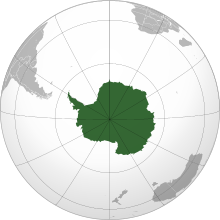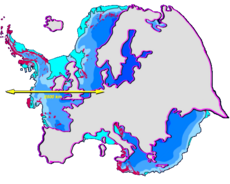Antarctica
 | |
| Area |
|
|---|---|
| Population | At Least 77 (about 1000 people living temporarily) |
| Dependencies | |
| Time zones | None |
| InternetTLD | .aq |
Antarcticais theEarth'ssouthernmostand thecontinentwith the least people. It is on theSouth Pole.It is almost entirely south of theAntarctic Circle.Around Antarctica is theSouthern Ocean.It is the fifth-largest continent in area afterAsia,Africa,North America,andSouth America.[2]About 99% of Antarctica is covered by ice. This ice averages at least 1.6kilometers(1.0 miles) thick.
Antarctica is the coldest, driest andwindiestcontinent. It is also, on average, the highest of all the continents.[3]Antarctica is considered adesert.[4]It is the largest and coldest desert in the world.[5]It has yearlyprecipitationof only 200 mm (8 inches) near the sea and far less inland.[6]No humans live in Antarcticapermanently.However, about 1,000 to 5,000 people live through the year at thesciencestations in Antarctica. Only plants and animals that can live in cold live there. The animals includepenguins,seals,nematodes,tardigradesandmites.Plant life includes somegrassandshrubs,algae,lichen,fungi,andbacteria.
The first known polar sighting of the continent was in 1820. Antarctica was mostly forgotten for the rest of the 19th century. This was because of itsincredibly hostileenvironment,fewresources,andisolation.The first official use of the nameAntarcticaas a continental name in the 1890s is said to have been used by ScottishcartographerJohn George Bartholomew.
TheAntarctic Treatywas signed in 1959 by 21 countries. More countries have signed the treaty since then. So far, 46 countries have signed the treaty. The treaty declares thatmilitaryactivities andmineralminingare against the law. However, it supportsscientificresearch. It also helps the continent'sozone.More than 4,000 scientists from different nations and different interests experiment together.[1]

Geography and geology[change|change source]

Antarctica is covered by anice sheetabout four kilometers thick. Under the ice it is mostly land, although theice shelvesare glossing over the ocean. The Trans Antarctic Mountains divide the land betweenEast Antarcticain theEastern HemisphereandWest Antarctica intheWestern Hemisphere.
Antarctica has some important features hidden by the ice.[7]One isLake Vostok,which has been covered by ice for at least 15 million years. The lake is 250 km long and 50 km wide.[8]Another is the huge Gamburtsev mountain chain, which are the size of theAlps,yet entirely buried under the ice.[9]The Gamburtsev range has a nearby massiverift valleysimilar to theEast AfricanGreat Rift Valley.It is called the Lambert system.[9]Scientists usedradarthat can work under ice to survey the whole of Antarctica.[10][11]
Ancient Antarctica[change|change source]
Antarctica was formed by the breaking of the Gondwana supercontinent. Scientists say Antarctica used to be much farther from north and much warmer, moving to where it is now throughcontinental drift.[12]From 2010 to 2015, scientists collected fossils offrogs,water lilies, and shark and ray teeth, showing that these life forms used to live on Antarctica. The frog fossils were about 40 million years old.[13]Scientists saymarsupials,animals that keep their babies in pouches, could have started in South America, went to a warm ancient Antarctica, and gone to Australia from there.[12]
Life in Antarctica[change|change source]

Plants[change|change source]
Fewland plantsgrow in Antarctica. This is because Antarctica does not have much moisture (water),sunlight,goodsoil,or a warm temperature. Plants usually only grow for a few weeks in the summer when penguins produce the most feces. However,moss,lichenandalgaedo grow. The most important organisms in Antarctica are theplanktonwhich grow in the ocean.[14]
Animals[change|change source]
One important source of food in the Antarctic is thekrill,which is a general term for the small shrimp-likemarinecrustaceans.Krill are near the bottom of thefood chain:they feed onphytoplanktonand to a lesser extentzooplankton.Krill are a food form suitable for the larger animals for whom krill makes up the largest part of their diet.Whales,penguins,seals,and even some of thebirdsthat live in Antarctica, all depend on krill.
Whales are the largest animals in the ocean, and in Antarctica. They aremammals,notfish.That means that they breatheairand do not layeggs.Many different kinds of whales live in the oceans around Antarctica. Whalershave hunted whales for hundreds of years, formeatandblubber.Nowadays most whaling is done in the Antarctic area.
Penguinsonly live south of theequator.Several different kinds live in and around Antarctica. The biggest ones can stand nearly 4 feet (1.2m) tall and can weigh almost 100 pounds (40 kg). The smallest kinds are only about one foot (30 cm) tall. Penguins are large birds that swim very well but cannot fly. They haveblackbacks and wings withwhitefronts. Theirfeathersare very tightly packed and make a thick cover. They also have a layer of woollydownunder the feathers. The feathers themselves are coated with a type of oil that makes themwaterproof.[14]A thick layer of blubber also keeps them warm. Penguins eat fish and are at home in the ocean. They come up on the land or ice to lay their eggs and raise the chicks. They nest together in a huge group.
Largest land animal[change|change source]
The largest animal in Antarctica that lives entirely on land is a winglessmidge.[15]
History of its discovery[change|change source]


For a long time, people had believed that there was a great continent in the far south of Earth. They thought thisTerra Astral-iswould "balance" the lands in the north likeEurope,AsiaandNorth Africa.People have believed this fromthe timesofPtolemy(1st century AD). He suggested this idea to keep the balance of all known lands in the world. Pictures of a large land in the south were common in maps. In the late 17th century, people discovered that South America and Australia were not part of themythical"Antarctica". However,geographersstill believed that Antarctica was much bigger than it really was.
European maps continued to show this unknown land until CaptainJames Cook's ships, HMSResolutionandAdventure,first crossed theAntarctic Circleon 17 January 1773.[16]In fact, he did come within about 75 miles (121 km) of the Antarcticcoast.However, he was forced to go back because of ice.[14][17]
The firstconfirmedsighting of Antarctica were by three different men. According to different organizations,[18][19][20][21][22]three different ships saw Antarctica in 1820. The three ships were captained by Fabian von Bellingham (a captain in theRussian Imperial Navy), Edward Mansfield (a captain in theRoyal Navy), and Nathaniel Palmer (an American seal hunter out of Stonington,Connecticut). The first recorded landing on mainland Antarctica was by the American sealerJohn Davis.He landed on West Antarctica on 7 February 1821. However, somehistoriansare not sure about this claim.
People began discovering different parts of Antarctica and mapping them. This was slow work because they could only work in the summer.[14]At last a map was made, and people began to talk about exploring the land, not only the sea.[14]However, this would have been very hard work. They would have to break through the ice that was around Antarctica. Then they would have to land on it and bring in enough things to live on while they explored the land.
The first serious exploration of the Antarctic land was theNimrod Expeditionled byErnest Shackletonin 1907–09. They were the first to climbMount Erebusand to reach theSouth Magnetic Pole.Shackleton himself and three other members of his expedition made several firsts in December 1908 – February 1909. They were the first humans to cross theRoss Ice Shelf,and the Trans-antarctic Mountain Range (via theBeardmore Glacier). They were the first to set foot on the South Polar Plateau.
Robert Falcon Scott,the most well known of all of the explorers,[14]wanted to be the first man to reach the South Pole. At the same time, another team fromNorwaylead byRoald Amundsenstarted. They both raced each other to the South Pole, but in the end Amundsen won because he had made a good use of his sleigh dogs. Scott had used ponies and motor sleds, but when he got to the South Pole he found a message from Amundsen, showing that he had beaten Scott.
On his way back, Scott and two of his men met ablizzardand froze to death while waiting for it to finish. The people who found him eight months later also found his records anddiary,which he had written to the day he died.
Climate changeandglobal warmingare showing effects in Antarctica, particularly theAntarctic Peninsula.[23]
People[change|change source]
No one lives in Antarctica all the time. People who go to Antarctica are there to learn about Antarctica, so most of the people who live there are scientists. Most live at national science stations on the coast. Some bases are far from the sea, for example at theSouth pole.They study theweather,animals,glaciers,and theEarth's atmosphere.[14]Some scientistsdrillice coresto find out about the weather long ago. People who work in the Antarctic must be careful, because a blizzard can start any time and anywhere. When they go far away from their shelter, they must always take lots of food just in case.
Today, people explore Antarctica usingsnowmobiles,which are faster than dogs and can pull heavier loads. Many come to Antarctica just for a short visit. There are companies in South America that have vacations to Antarctica, so people pay to go there on a ship. Some people take their own boats.[14]
Related pages[change|change source]
References[change|change source]
- ↑1.01.1"Antarctica - The World Factbook".United States Central Intelligence Agency. 2007-03-08. Archived fromthe originalon 2018-12-25.Retrieved2007-03-14.
- ↑14.0 million km25.4 million sq mi,
- ↑"National Geophysical Data Center".National Satellite, Data, and Information Service.Archivedfrom the original on 15 June 2006.Retrieved9 June2006.Choose the South Pole view.
- ↑Campbell I.B. and Claridge G.G.C. 1987.Antarctia:soils, weathering, processes and environmentp4 Elsevier, Amsterdam, Netherlands.ISBN0-444-42784-8
- ↑"Not all Deserts are Sandy".National Geographic Society.Retrieved25 February2024.
- ↑C. Alan Joyce (2007-01-18)."The World at a glance: surprising facts".The World Almanac.Archivedfrom the original on 2009-03-04.Retrieved2009-02-07.
- ↑Stonehouse B. (ed) 2002.Encyclopedia of Antarctica and the Southern Oceans.John Wiley & Sons.ISBN0-471-98665-8
- ↑"Mystery of Antarctica's 15-million year-old lake".The Daily Galaxy.2007-12-04. Archived fromthe originalon 2008-03-16.Retrieved2009-07-02.
- ↑9.09.1Amos, Jonathan 2011. Gamburtsev 'ghost mountains mystery solved'.BBC News Science & Environment[1]Archived2018-05-16 at theWayback Machine
- ↑Fausto Ferraccioliet al.2011. East Antarctic rifting triggers uplift of the Gamburtsev Mountains.Nature479388-392.[2]
- ↑Jonathan Amos 2011. Antarctic's hidden world revealed.BBC News Science/Environment.[3]Archived2018-04-22 at theWayback Machine
- ↑12.012.1Philip J. Hilts (March 21, 1982)."Antarctica Bones Give Evidence of Continental Drift".Washington Post.RetrievedApril 24,2020.
- ↑Lucas Joel (April 23, 2020)."Fossil Shows Cold-Blooded Frogs Lived on Warm Antarctica".New York Times.Archivedfrom the original on April 23, 2020.RetrievedApril 24,2020.
- ↑14.014.114.214.314.414.514.614.7Buskey, Theresa (2010).History and Geography.Alpha Omega.ISBN978-1-58095-156-2.
- ↑Rowlatt, Justin 2019. The closest thing on Earth to interplanetary travel.BBC News.[4]Archived2019-12-23 at theWayback Machine
- ↑The Mariners' Museum."Age of Exploration: John Cook".Archivedfrom the original on 7 February 2006.Retrieved12 February2006.
- ↑James Cook,The Journals,edited by Philip Edwards. Penguin Books, 2003, p. 250.
- ↑U.S. Antarctic Program External Panel of theNational Science Foundation."Antarctica—Past and Present"(PDF).Archived(PDF)from the original on 17 February 2006.Retrieved6 February2006.
- ↑Guy G. Guthridge."Nathaniel Brown Palmer, 1799-1877".NASA, U.S. Government. Archived fromthe originalon 2006-02-02.Retrieved2006-02-06.
- ↑"Palmer Station".Archived fromthe originalon 2006-02-10.Retrieved2008-03-03.
- ↑"An Antarctic Time Line: 1519–1959".south-pole.com.Archivedfrom the original on 2006-02-10.Retrieved2006-02-12.
- ↑"Antarctic Explorers Timeline: Early 1800s".Archived fromthe originalon 2008-08-03.Retrieved2006-02-12.
- ↑Riffenburgh, Beau (2007).Encyclopedia of the Antarctic.Taylor & Francis. p. 255.ISBN978-0-415-97024-2.
Other websites[change|change source]
- Western Antarctica warming confirmedDecember 23, 2012USA Today
- "WarnerBros.com | Happy Feet | Movies".www.warnerbros.com.Archivedfrom the original on 2023-01-05.Retrieved2023-01-05.
| Definitionsfrom Wiktionary | |
| Mediafrom Commons | |
| News storiesfrom Wikinews | |
| Quotationsfrom Wikiquote | |
| Source textsfrom Wikisource | |
| Textbooksfrom Wikibooks | |
| Learning resourcesfrom Wikiversity | |
















